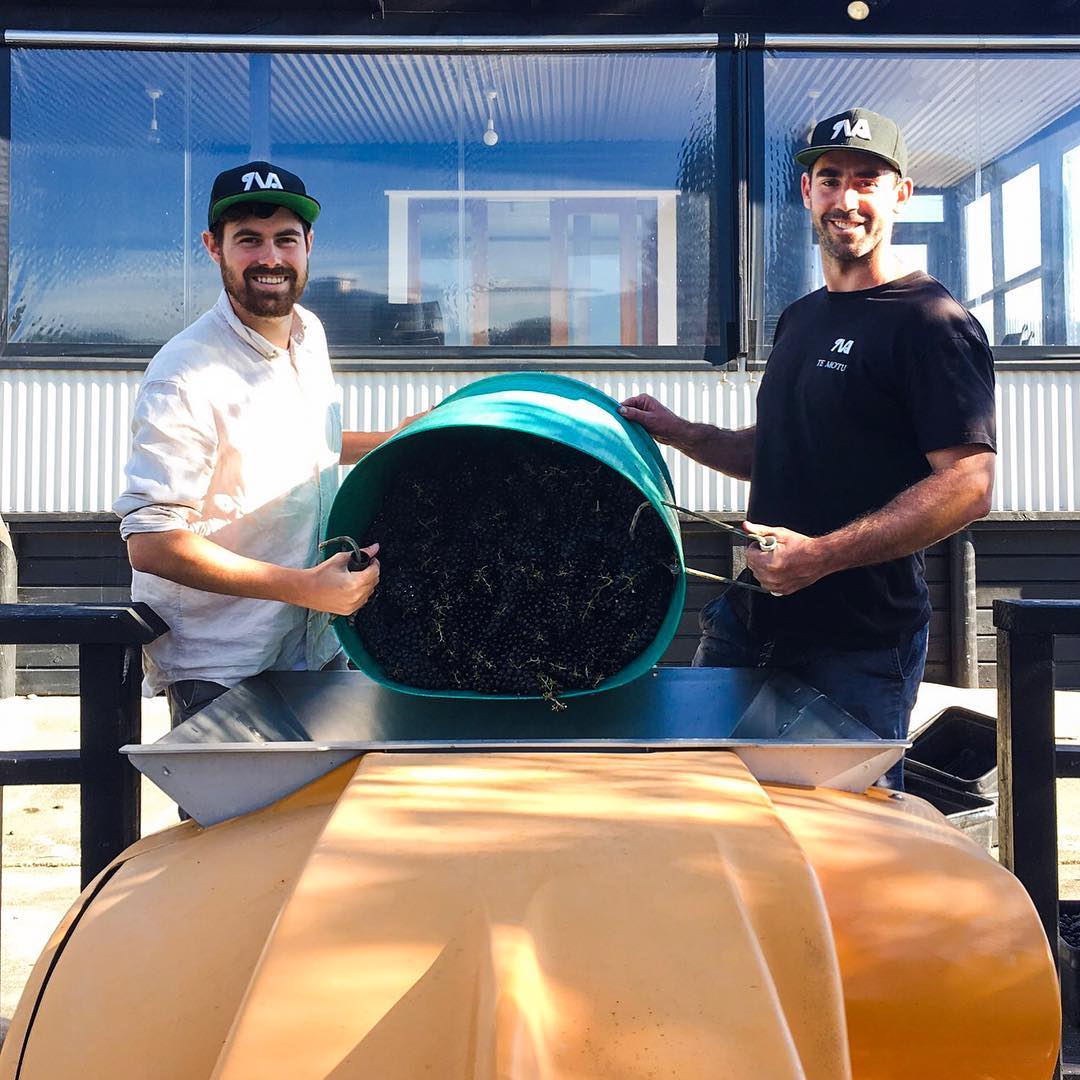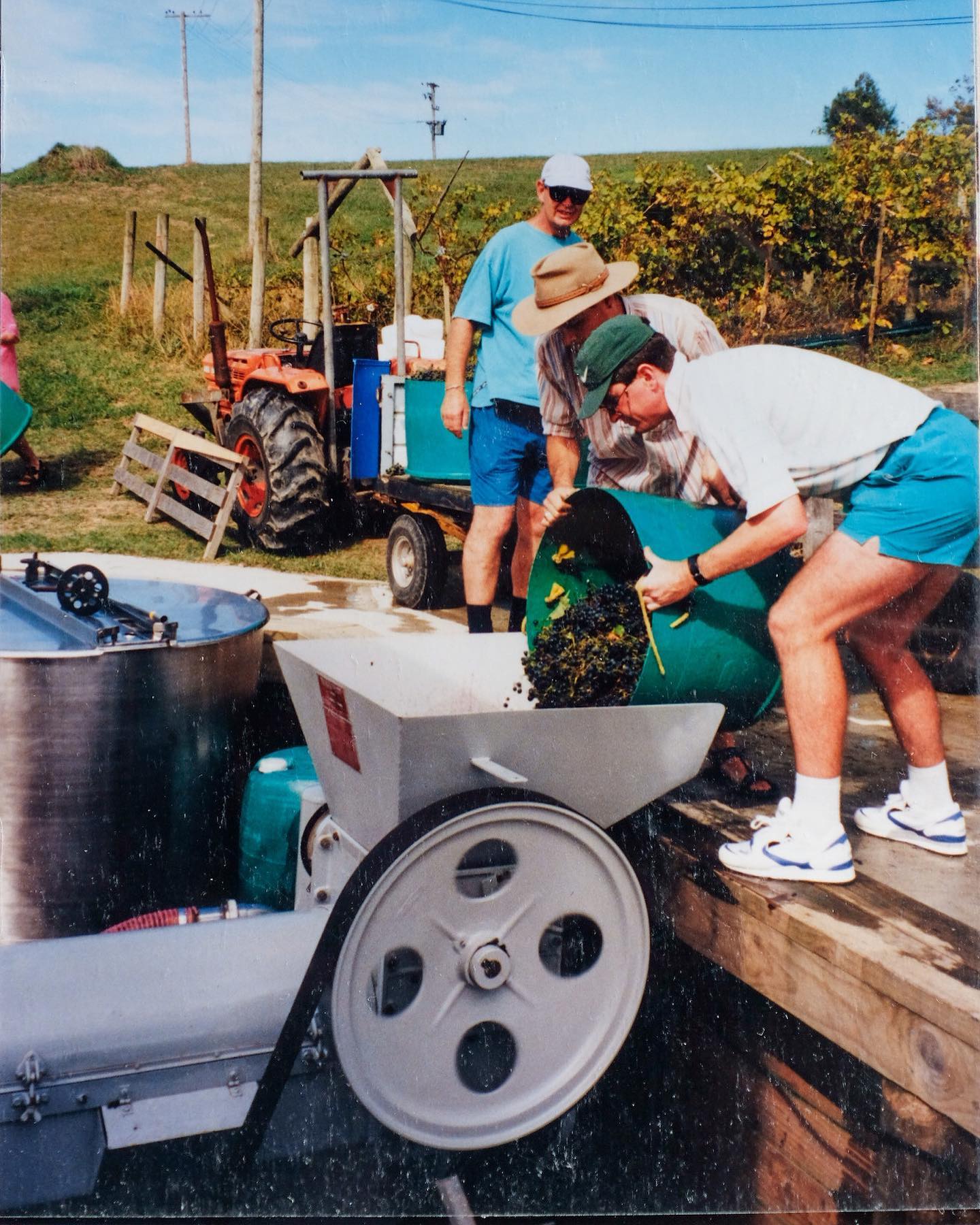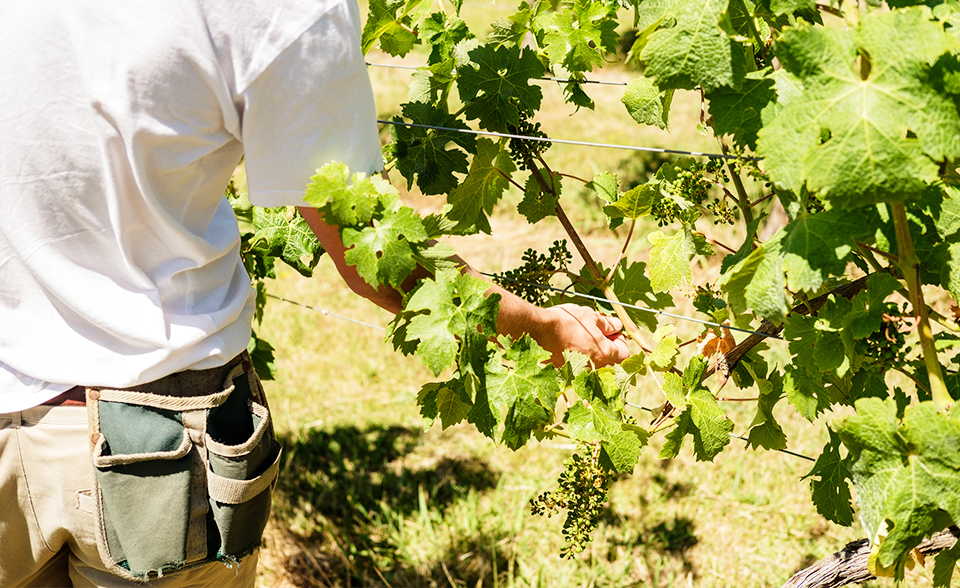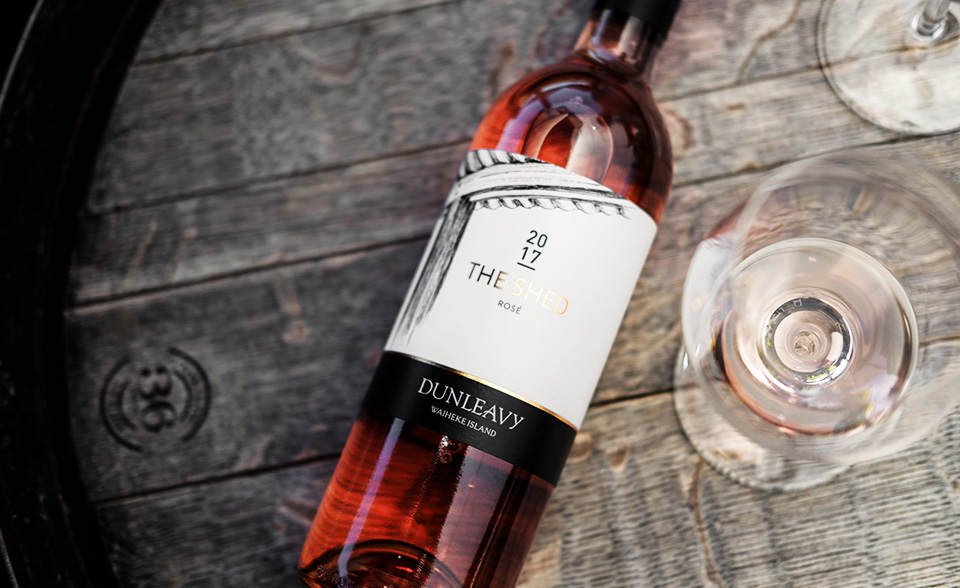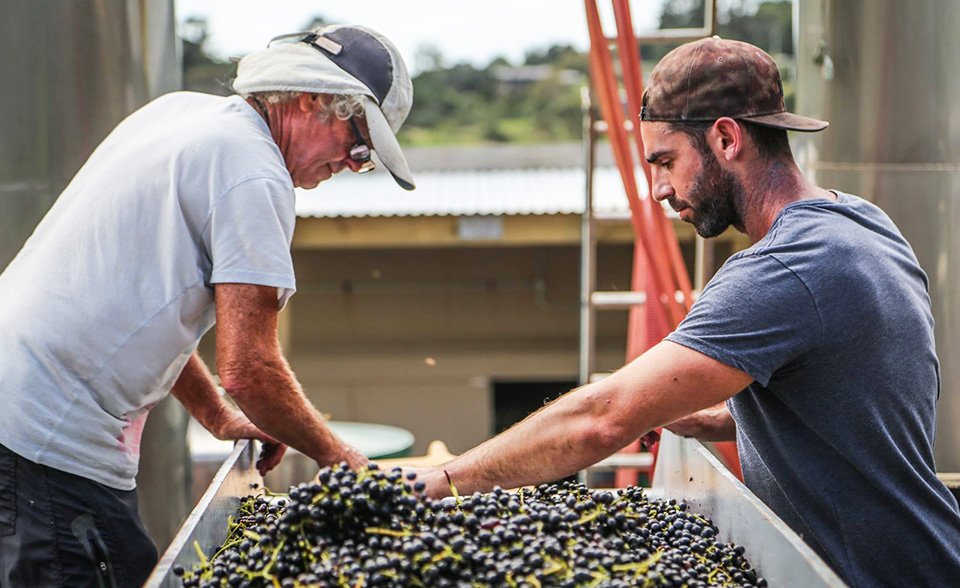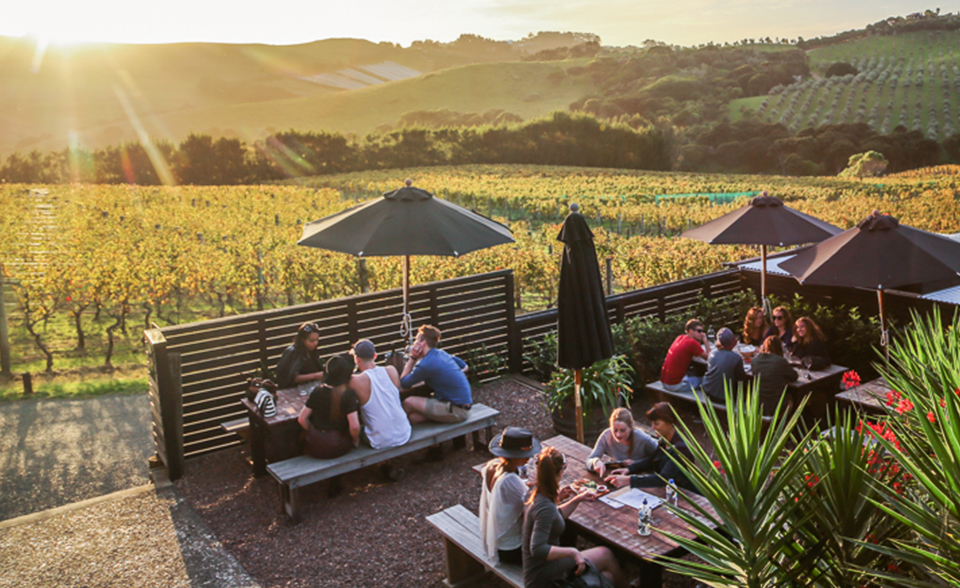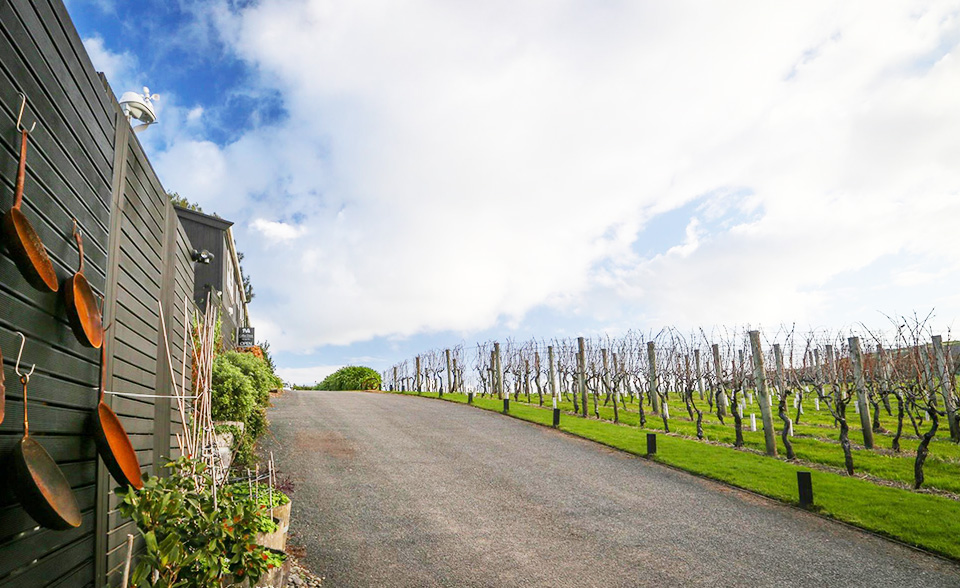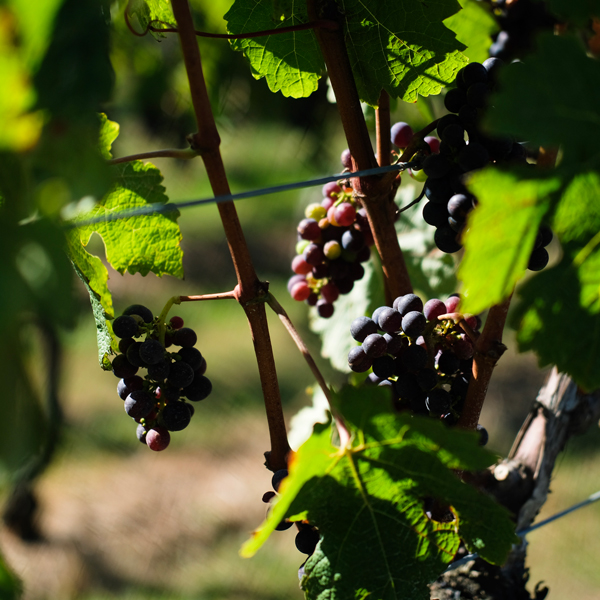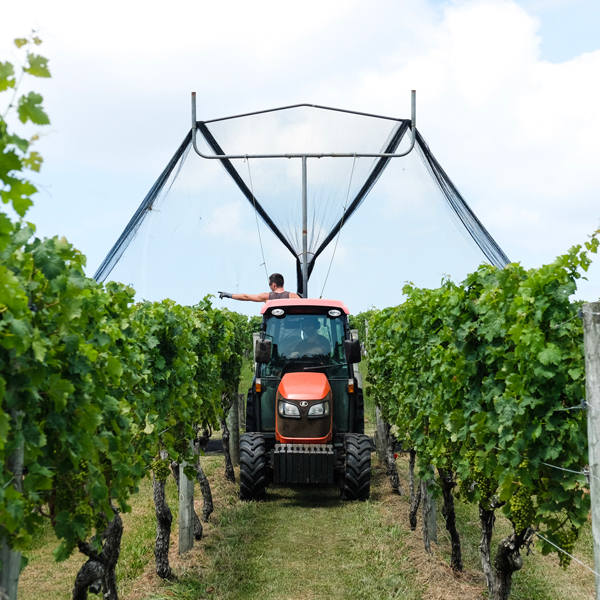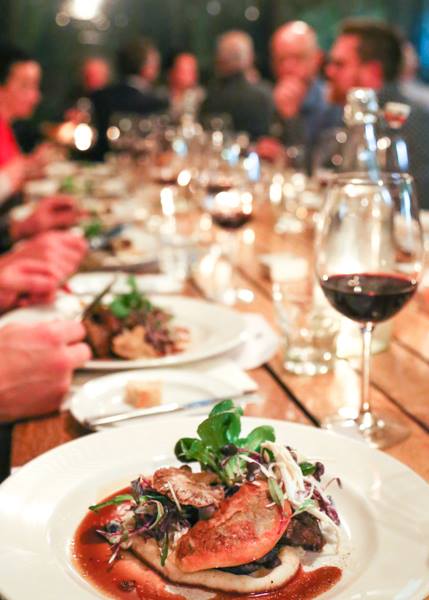Our Heritage
The vineyard’s name ‘Te Motu’ comes from the original Maori name for Waiheke, Te Motu Arai Roa ‘island of long shelter’.
The Te Motu Vineyard’s story began in 1988 when the Dunleavy family procured 30 acres of prime “vineyard valley” and nourished it into a haven of premier wine. As one of the pioneers of the Waiheke wine movement, the family’s vision was clear from the outset: To master wines of the ‘Bordeaux’ style, comprised predominantly from a blend of Cabernet Sauvignon and Merlot. In 1989 the first vines were planted. The first vintage of Te Motu was produced in 1993.
Te Motu’s vineyard lies in the heart of Waiheke Island’s Onetangi Valley, where it is sheltered from the north by the ridge which guards Onetangi’s famous beach, and from the west by the massive rocky outcrop known as Stonyridge. One of Te Motu vineyard’s boundaries is formed by the Rangihoua creek, which flows into an inlet of Putiki Bay. The inlet was named Te Rangihoua, ‘day of renewal,’ by Tama Te Kapua, captain of the Maori canoe Te Arawa – because it was his first landfall in the long voyage from Hawaiiki. There, Te Arawa was relashed before continuing on to its final landing place at Maketu.
A taste of the land
Waiheke Island’s Onetangi Valley features Jurassic-age Waipapa Group soil and a unique micro-climate, making it one of the best places in the world to grow Cabernet and Merlot grape varieties. The original rock composition has been largely converted to clay minerals and enhanced by many years of soil testing and element application.
Te Motu’s soil quality is outstanding, and its north-facing location retains warmth overnight, enhancing the development of the natural phenolic compounds that affect the taste, colour and mouth-feel of wine. It is this unique mesoclimate that supports a long, steady but slow growing season – perfect for the production of highly complex and long-lived wines.
TE MOTU PHILOSOPHY
Balance in all things
The vision at Te Motu is simple: to produce wines that express the unique terroir of Onetangi Valley and continue to evolve and improve with age. To this end, it is important that vineyard and winery practices work towards balance at all stages.
Using only the highest quality fruit, harvested at optimum ripeness, affords a lower intervention, crafted approach. The belief is: the more a wine is handled before bottling, the more is taken from the finished wine. Most years, crops are green harvested to achieve physiological ripeness at relatively moderate alcohol levels.
Berries are hand harvested from low-yielding vines, and gently de-stemmed (not crushed) within 15 minutes of harvest. Wines are matured in barrel for twelve to eighteen months depending on the cuvee and the needs imposed by the vintage. Barrels are sourced from a diverse range of the best French coopers to enhance the complexity of the blend. The percentage of new wood used varies depending on the ripeness, weight and extract of the wine as defined by the vintage.
The Te Motu flagship wine is a Cabernet Sauvignon dominant blend with Merlot, Cabernet Franc and Malbec. The blend varies from year to year and on average only 4500 bottles are made in each vintage. Each constituent variety is aged separately in its barrels, which are tasted after about 12 months, to determine which shall be drawn off, leaving the best to mature another six months before being bottled as Te Motu. Typically, Te Motu is bottle aged a further three and a half to four years before being released.
OUR ARTICLES
The Art of Aging a Fine Red Wine
Many wines available today can be enjoyed right after you’ve bought them. In some cases, however, it may be worth buying a bottle (or a case) of a good vintage and letting it age. This will help develop its flavour, soften the tannins, and bring out its unique characteristics. Then, when you do finally open it, you’ll be able to fully experience what makes that particular wine unique.
Why age wine?
Ageing will change the aroma, flavour, and texture of a wine. Young red wines are often heavy on tannins. These can make the wine taste a bit dry and give it an astringent feel. Ageing helps break these tannins down, ‘softening’ them and giving the wine a smoother, more rounded texture. High quality wines will also gain in complexity of aroma and flavour. Red wines generally start with mainly fruit characteristics, and with ageing will gain savoury or ‘meaty’ notes, as well as toasty notes from time in barrel.
How is wine aged?
Wine is often aged in two stages. The first is at the vineyard in barrels, after fermentation. Wine can then be aged further while in the bottle.
Barrel ageing:
As part of the process of producing a wine, it will often be left to age in special barrels for anywhere between 6 and 30 months. This helps develop its flavour, mature the wine, and help improve the longevity of the wine after it’s bottled. Red wine is usually aged in some portion of new oak barrels, which imparts extra flavour and depth to the wine. Some common flavours from new oak are cedar, smoke, vanilla, baking spices, and toast. Oak barrels also allow a little bit of air to be introduced into the wine which helps soften tannins and make the wine less astringent.
Bottle ageing:
After bottling, a wine can be sold immediately. Sometimes, however, a winery will leave the wine to continue to age in its bottle, before releasing it for sale. This is to ensure the wine is at optimal drinkability and has the flavour profile and mouthfeel as intended. These wines are perfect for enjoying right away or can continue to be aged at home.
Here at Te Motu we use only the highest quality fruit, harvested at optimum ripeness, to afford a lower intervention, crafted approach. Our belief is: the more a wine is handled before bottling, the more is taken from the finished wine. Therefore, most years, crops are green harvested to achieve physiological ripeness at relatively moderate alcohol levels.
For our Cabernet Sauvignon dominant flagship wine, ‘Te Motu’, we age the wine in barrel for 18 – 24 months with a portion of new oak barrels. When deciding on the amount of new oak, our goal is to add complexity to the finished wine, yet still have the quality and purity of fruit shine through. We further age our wine in bottle, and release the ‘Te Motu’ at minimum 5 years of age, yet recommend further aging. Many vintages are capable of aging 20+ years.
How do I age wine at home?
If you decide to age a bottle of wine at home, there are two main factors to consider. The first is where and how you store the bottle, the second is making sure you’ve selected the right wine to age.
To age wine successfully, you need to pick your spot well. It should be dark, cool, and humid. If you have a dark, cool space under your home that doesn’t fluctuate much in temperature, this could be a good option. You can also buy a special fridge to hold your wine at an optimal temperature, or you could find a dark cupboard that, again, doesn’t fluctuate too much in temperature.
The reason it’s ideal to keep your wine in a humid environment is to help keep the cork moist. This is also why you see most cellared wines lying on their side. While many wines today come with a screw top, many premium wines – including those suitable for ageing – are still often closed with a cork.
This leads to the second factor: buy the right wine. Not all wines are ripe for ageing, but there are a few clues to help you choose one that will. Price is the first indicator. Cheaper wines are generally designed to be drunk immediately, or within a year or two of purchase.
Robust, full-bodied wines, like a red Bordeaux, tend to age the best. Cabernet Sauvignon, Cabernet Franc, Merlot, Malbec or Syrah – or a blend of these – are also good choices. Often, the label or description of the wine will tell you if the wine is best to drink right away, or if it would benefit from further ageing.
If you’re purchasing at the cellar door, expert winery staff can guide you on the best wine to purchase based on your preferences.
How long should I age wine?
How long you age a wine will depend on the type of wine you’ve bought. A red Bordeaux blend, for example, does well with a couple of decades of ageing – as long as it’s kept in the right environment. In contrast, a Malbec or Syrah usually only needs to be cellared for five to ten years before they’re at optimum drinkability.
Whether you decide to cellar your wine or enjoy it now is entirely up to you. Some people like the idea of keeping a favourite wine to be enjoyed on a special occasion or gifting a bottle to someone for a special occasion.
If a wine is a special vintage released by your favourite winery, cellaring a few bottles means you’ll be able to enjoy a wine that may no longer be for sale. Even better, if you buy a case, you’ll be able to enjoy the wine as it ages.
What is a Bordeaux-Style Blend?
To understand what a Bordeaux-style blend is, we must first understand a little bit more about the Bordeaux region and its wine tradition.
Bordeaux, France
Bordeaux is a beautiful region on the west coast of France. You’ve probably heard the name and its association with fine wine. That’s because the region’s climate and soil are ideal for growing wine grapes.
Its location close to trading routes meant traditionally that the wine was readily shipped around the world, creating familiarity with Bordeaux wine. Today, one could argue that Bordeaux wines are some of the most coveted and well-known wines around the world.
Like many other famous regions, such as Chianti or Champagne, the wine itself has less to do with one particular grape, but rather the unique regional tradition in which the wine is made.
Bordeaux wines are made from a specific blend of grapes, with Cabernet Sauvignon and Merlot being the dominant grape varietals. Cabernet Franc also often makes an appearance, with lesser amounts of Petit Verdot, Malbec and occasionally Carménère. You can also get a white Bordeaux, which is a blend of Sauvignon Blanc, Sémillon and Muscadelle. Sauternes, made from the same white varieties is a world-renowned dessert wine.
Even within the Bordeaux region, there are variations in the wine blend. Bordeaux is divided in two by a river estuary called the Gironde, which creates two distinct areas: the left bank, and the right bank. Each lends itself to the cultivation of one particular grape over the other. As a result, vintners on each bank have historically ended up blending their wines differently.
Those on the ‘left’ bank created wines with Cabernet Sauvignon as the dominant grape, as the soil and climate of this side of the river helped to reliably ripen this thick-skinned grape. This was then blended with lesser amounts of Merlot, Cabernet Franc, Malbec and Petit Verdot. Cabernet Sauvignon is less successful on the other side of the river, so vintners on the ‘right’ bank blended their wines with Merlot as the dominant grape, often blended with a Cabernet Franc.
Even with these variations in blends, a Bordeaux wine is characterised as a medium to full-bodied wine, with rich plum, blackcurrant, savoury, and earthy notes, as well as firm tannins that give the wine a rich texture.
And, because high quality wines from both Cabernet Sauvignon and Merlot grapes have the potential to age well, increasing in complexity of flavour and aroma, and becoming more rounded as they age, Bordeaux blends are often sought-after collector’s items.
Bordeaux blends around the world
Because of strict regulations, only wines produced in Bordeaux that use grapes grown in Bordeaux can be classified as a ‘Bordeaux’ or ‘Bordeaux blend’. However, the Bordeaux grape varieties grow well around the world, so wine producers globally produce wines with these grapes in the style of a Bordeaux wine – calling them a ‘Bordeaux-style’ blend.
In the same way that there are unique differences in the wines produced in Bordeaux, Bordeaux-style blends around the world each bring their own characteristics to the style. These unique characteristics often come from differences in climate, soil, or vineyard practices and is often referred to as a sense of place, or ‘terroir’.
While there’s room for vintners to experiment with the blend, for it to be a true Bordeaux-style blend the wine must be made primarily from Merlot and Cabernet Sauvignon grapes. This gives vintners around the world the opportunity to use the Bordeaux grape varieties that grow best in their region, while still producing a quality wine that has the same qualities and flavour profile as a true Bordeaux.
Bordeaux-style blends in New Zealand
New Zealand has many areas where Bordeaux grape varieties thrive. Cabernet Sauvignon especially requires heat to ripen fully, but they don’t like it too hot. This is why areas like Waiheke Island and the Hawke’s Bay are perfect for creating Bordeaux-style blends. They offer plenty of sunshine and warm days, tempered by close proximity to the ocean, so it doesn’t get too hot.
In fact, the climate on Waiheke Island is similar to that in Bordeaux, France. They both have maritime climates, influenced by their proximity to the ocean, which acts as an insulator – it doesn’t get too hot, or to cold, and allows for a long growing season in which grapes can slowly ripen, giving full flavour while retaining freshness.
Te Motu’s vineyard lies in the heart of Waiheke Island’s Onetangi Valley, where it is sheltered from the north by the ridge which guards Onetangi’s famous beach, and from the west by the massive rocky outcrop known as Stonyridge. This helps create the perfect slow-ripening environment that gives these wines their unique flavour and complexity.
At Te Motu, our vision is to master age-worthy Bordeaux-style wines, while showcasing the unique terroir of our sheltered slice of Onetangi Valley. Our flagship wine, Te Motu, is comprised predominantly from a blend of Cabernet Sauvignon and Merlot grapes, with Cabernet Franc and occasionally Malbec and Carménère. Our first vines were planted back in 1989 and our first vintage was produced four years later.
Next time you’re looking to enjoy a rich, red Bordeaux, don’t limit your search to the Bordeaux region – you’ll find some amazing Bordeaux style blends in your own backyard. You could even visit a winery that creates wines in the Bordeaux style to develop an even greater appreciation for these delectable wines, then take some home to age and enjoy over the coming years.
Recommendations for Pairing a Fine Red Wine With Your Meal
There’s nothing like enjoying a fine wine with a meal. It’s a simple way of making any meal feel a little more indulgent or mark it as a special occasion. Aside from the occasion, the right wine can enhance and complement the flavours of the food you’re eating and vice versa.
Choosing which red wine will pair best with your meal may seem complicated and daunting, but there are some simple guidelines you can follow to get it right every time.
Bold wines go well with bold foods, while more delicate wines can be overpowered by rich dishes. Sweetness and umami in food can make wines seem more hard and less fruity, but salt and acidity generally make wines seem softer and fruitier. Many people enjoy pairing wine with food that has complementary flavours – a savoury and earthy Cabernet with steak and mushrooms. Yet sometimes using a higher acid wine as a palate cleanser is very satisfying!
Red wines in general, and especially a red Bordeaux, tend to go better with richer, heartier meals. The tannins and acidity help cut through the fattiness of meats like steak and lamb by clearing your palate and helping you enjoy the flavour of the meat with each bite.
That same richness of flavour in the wine means that they can often pair well with rich, tomato-based dishes. A Cabernet Sauvignon, for example, will pair equally well with a perfectly cooked steak or a delicious ratatouille.
The ‘Te Motu’ flagship wine is a Cabernet Sauvignon dominant blend with Merlot, Cabernet Franc and Malbec, hand harvested from low-yielding vines. The wine enjoys extended élevage and maturing in premium French oak before beginning a minimum 3-year term resting in bottle. The blend used varies from year to year, and on average only 4,500 bottles are produced in each vintage.
You could also try our 2017 ‘Kokoro’ Bordeaux-style wine – a Merlot dominant blend with Cabernet Sauvignon, Malbec and Syrah. Or, pair your meal with our 2015 ‘Kuikui’ 100% Syrah. We also have many wines under our Dunleavy range that are great for everyday pairings!
Here are a few great red wine and food pairings to try
A Cabernet Sauvignon generally has high acid and tannin so it is a great choice if you’re eating a meal that’s hearty and rich. Steak and lamb pair well with this wine, as do portobello mushrooms and hard, strongly flavoured cheeses like pecorino, aged cheddars and goat’s cheese. For a special occasion, try a vintage of our ‘Te Motu’ flagship with roast lamb, or for more everyday try our Dunleavy ‘The Strip’ with grilled portobello.
Merlot is another red wine that you can pair with richer dishes, yet is softer and more rounded than Cabernet Sauvignon. Along with meaty dishes like steak, pork and roast chicken, a Merlot will also pair well with tomato-based dishes, including tomato-based pasta. Our ‘Kokoro’ blend goes beautifully with charcoal grilled pork loin and chimichurri.
If you’re pairing your food with a Bordeaux, check which grape variety is most prominent in the wine. This will give you a good indication of which type of food it will pair with best, based on the above.
If you’re into boldly flavoured, or foods on the spicy side, give Malbec a try. As it’s not quite as rich in tannins, it can pair really well with leaner meats. It’s also a great wine to pair with a juicy burger – if that’s what you’re into.
Pinot Noirs, meanwhile, pair perfectly with gamy, earthy dishes – think venison, mushroom risottos or even salmon. It’s a very versatile wine, so will pair well with both meat and vegetable dishes. But, because it’s not as rich in tannins as a Cabernet or Merlot, it doesn’t work as well for richer, fattier meats. It’s also a great wine to pair with more subtle cheeses like Gruyere or Havarti. While we don’t produce Pinot Noir, our Dunleavy ‘The Family’ Merlot blend is produced in a lighter style and goes well with leaner meats and subtle cheese.
Syrah pairs well with grilled meat or vegetables. So, if you like barbequing, this could be an option to try. It also pairs well with falafel and pasta puttanesca. For special occasions, our ‘Kuikui’ pairs well with char grilled Wagyu, or for your next get together, try our Dunleavy ‘The Grafter’ with lamb and veggie skewers.
If you’re a fish and red wine lover, don’t despair. While a little less common, fish and red wine can go together. A lighter Pinot Noir will go well with white fish or salmon, as well as other seafood like oysters, crab, lobster, or mussels. Meanwhile, if you’re definitely a bold red wine drinker, go with tuna or swordfish. Also, important to consider is what sauce or accompaniments you have with your seafood – bold reds pair great with salty and fatty sauces!
If you find it hard to remember specific food pairings for red wine with food, here are some key things you can keep in mind.
– Red wine, in general, pairs well with rich, hearty foods, as it tends to overpower delicate flavours. This is why you wouldn’t generally pair red wine with a delicate white fish, or a salad.
– If you’re planning a wine and cheese evening and will be serving predominantly red wine, go with strong, hard cheeses like aged cheddars and pecorino, though blue cheese can work well too.
– Vegetarian dishes can work really well with red wine too. Tomato-based pasta sauces and stews can pair nicely with a robust red wine, as do mushrooms.
– Don’t forget dessert. If you’re after a sweet dessert rather than a cheese board, chocolate and wine are a match made in heaven. Dark chocolates go very well with Cabernet Sauvignon and Merlot. But steer away from pairing a bold red with very sweet dishes.
Final thoughts
The most important thing to consider when pairing wine with food is to choose a wine that you like. Don’t drink a wine you’re not a huge fan of, just because it matches the food. Experiment, and learn what you like and don’t be afraid to experiment a little. You’ll soon find what works for you and what doesn’t.
And, if you’re ever after any inspiration, next time you’re at a restaurant check what their wine and food pairing recommendations are and give them a go. You’ll be able to get a feel of why a certain wine works with a certain food, and the extra dimensions the pairing adds to both.


